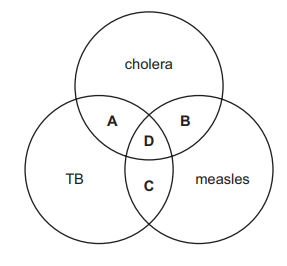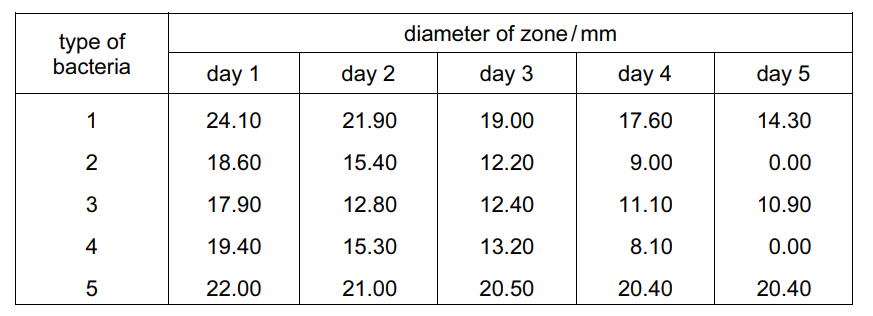Question
Which diseases are treated with antibiotics?

Answer/Explanation
Ans:
A
Antibiotics are used to treat tuberculosis (TB) and cholera, but they are not effective against measles. Measles is a viral infection and can only be treated with supportive care to help manage symptoms.
Question
The diagram shows one way of testing the effect of an antibiotic on bacteria.

The table shows the results of testing five different types of bacteria. Zones of less than 13 mm show the presence of resistant bacteria.

Which statement can be supported by this data?
- All the types of bacteria become resistant to antibiotics over time.
- Only types 2, 3 and 4 of the bacteria show resistance to the antibiotic.
- The antibiotic can be used to treat types 1 and 3 only.
- Type 5 of the bacteria can never become resistant to the antibiotic.
▶️Answer/Explanation
Ans:
B
Question
Bacteria that infect skin wounds can become resistant to the antibiotic commonly used to kill
them.
Which statement explains how these bacteria could become resistant to the antibiotic?
A Exposure to the antibiotic causes a change in the bacterial cell wall, preventing the antibiotic
from working.
B Other bacteria that normally protect the skin against infection are killed by the antibiotic,
allowing the infectious bacteria to survive.
C Random mutations in DNA allow some of the bacteria to survive in the presence of the
antibiotic.
D The antibiotic causes the bacterial DNA to mutate, allowing the bacteria to survive in the
presence of the antibiotic.
Answer/Explanation
Answer: C
Option C, random mutations in DNA allow some of the bacteria to survive in the presence of the antibiotic, explains how bacteria can become resistant to antibiotics. Over time, these mutations can lead to the development of antibiotic-resistant strains of bacteria.
Question
What is not an example of antibiotic action?
- damage to cell surface membranes
- prevention of protein synthesis
- prevention of synthesis of new cell walls
- stimulation of antibody production
Answer/Explanation
Ans:
D
Option D, stimulation of antibody production, is not an example of antibiotic action. Antibiotics work by damaging bacterial cell structures or inhibiting bacterial cell functions, while antibody production is a function of the body’s immune system.
